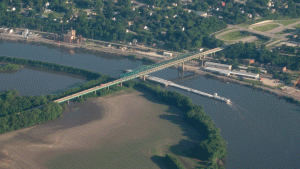The Pilot Golfer
An epic dilemma on a day off: Do you hit the greens or the wild blue? To which I say, why choose if a course is located reasonably close to GA-friendly airports. Of course, there may be challenges getting from the home airport to the course, with weather delays and other vagaries of aviation that make you late for the tee time. All part of the fun, and the best golf destination isn’t merely accessible to the pilot-golfer, but for the pilot-golfer. And what destination says “Fly here and golf” more clearly than one that goes through the trouble of putting in a private airstrip? It’s the ultimate red carpet for private pilots. I have played at one of these but there are many courses accessible by
 courtesy car or inexpensive rental. Today we would be heading to one of those.
courtesy car or inexpensive rental. Today we would be heading to one of those.Lighter, smaller golf bags with less than the regular compliment of clubs were stashed in the back. The weather surrounding the destination advertised 10 mile plus visibility. Clear skies at the home drome but 2,500’ expected ceilings en route. The destination airport had lower ceilings listed in the metars but the surrounding airports were acceptable. It could be a faulty ASOS report. It’s happened before.
I really don’t need more challenge in my golf game or for that matter in my flying. Unfortunately, both activities are weather dependant. Mother Nature has a mind of her own and would make this golf outing as much fun as an alligator filled water hazard.
It was a VFR day. Although instrument rated, I didn’t carry the tools of the trade: Approach plates, en route charts or a plane with accurate nav radios and the Bendix GPS was inoperative. According to the forecast I wouldn’t need them. The initial part of the trip was great. Smooth air and good visibility but after the first hour, clouds appeared and ceilings began to get lower. We pressed on. We had a tee time to make.
A superior pilot uses his superior judgment to avoid having to exercise his superior skill.
I don’t lay claim to either but I do know this excludes scud running. This is regarded as maintaining visual contact with the ground while avoiding physical contact with it. Conditions are usually low ceilings and visibility less than 3 miles. There was a time when scud-running was common place, but with the advent of instrument flight it is not legal to fly lower than 1,000 feet above ground in populated areas and less than 500 feet above structures in remote places. When the weather gets bad, you’re supposed to fly on instruments. Many an accident occurs when pilots continue visual flight into instrument conditions. The thing is, you never know when that’s going to happen. Not exactly. Sure, you get a full weather report from DUATS or a flight service station briefer, and updates from Flight Watch en route. But still, those are just forecasts. It can happen in seconds. Before you know it, you run out of visibility or altitude or options. My not so superior judgment came into play as visibility became worse. It was marginal visual flight rules (MVFR) and I could tell it was getting worse quickly. Without the ability to navigate to an airport I decided not to enter the clouds which also are prohibited without an instrument flight plan, in contact with ATC. I made a one eighty and diverted back to an alternate airport where we waited for conditions to improve. An hour an a half later we tried again. On the second attempt we made a lot of progress, now only 14 miles away and just cleared a series of tall hills. Visibility and ceilings appeared to be reduced up ahead but I couldn’t be sure. It was still MVFR. Should I press on and find out? We were within five minutes of our destination but I only had seconds to make the call. We had a tee time to make.
I turned around again.
Why? We were now at our lowest permissible altitude. There were tall radio towers, rising terrain and falling ceilings. This time I diverted to a major airport with passenger terminals. It was nice to be in contact with air traffic control who could call out if someone else was gooning it up in the murk, preventing a meeting in mid air. From here we rented a car and made a long drive to the course to make our fourth scheduled tee time.
 The golf was spectacular, the flight home terrific but it could have ended badly.
The golf was spectacular, the flight home terrific but it could have ended badly.The Downside of Scud Running
By piecing together information from reports, we learn about another scud running pilot with a different outcome while flying through a mountain pass. On the far side is better weather and home. Behind is a tent, camp, cold and wet weather, and insufficient gas to go elsewhere. The pilot continues deeper into the pass, hoping conditions would improve. The ceiling steady, but the terrain is rising. He heads south, and winds are westerly at 20 knots, with gusts. The pilot hugs the right side of the pass for traffic.
Suddenly, clouds obscure the rising terrain, and it’s obvious he isn’t going to make it through the pass. It’s time to turn around, but the opposite canyon wall looks awfully close. The aircraft’s vertical fin is already in the clouds, and the surrounding terrain is much higher—climbing isn’t an option. Neither is a descent. From cruise configuration, the pilot initiates a hard left turn, banking 45 degrees. Unfortunately, the aircraft has just turned into a tailwind.
Two days later, searchers find the remains of the aircraft near the top of the pass. The wreckage pattern leads downhill, on a northerly heading. The NTSB accident database is littered with stories of pilots who failed to turn around in the space available to them. Pose this question to a dozen pilots, and you’ll hear as many answers. Some advocate a chandelle—a climbing turn at the conclusion of which you should be within a couple knots of stall speed. Risky to be close to stall speed in the hilly terrain and turbulence. Others suggest a diving turn. But there comes a point where you can no longer descend.
Lessons Learned
A couple of notes to self on the trip: First, if there is any question about visibility and ceilings it’s best to fly on an instrument flight plan. Although it is illegal to intentionally climb into IFR conditions without a clearance, such an option might be considerably safer than continuing in IMC at a low altitude but without charts and frequencies you may be relegated to declaring an emergency on 121.5. Second, it was the right decision to divert both times, actually about a minute late the first. Landing at alternate airports and waiting burned up much more time then if we used a car instead of a plane.
Another deposit into the bag of experience from the bag of luck. I learned about flying from that.
 For EAA members you can log in to see the action from multiple cameras from the grandstand area including the 500 mph-plus Unlimiteds from the back side of the course. Also several in-cockpit cameras will be available, and shots from the pylons. Log in at
For EAA members you can log in to see the action from multiple cameras from the grandstand area including the 500 mph-plus Unlimiteds from the back side of the course. Also several in-cockpit cameras will be available, and shots from the pylons. Log in at 
 same railroad tracks that Charles Lindberg used for navigation during his air mail route to St. Louis. Contract Route No 2 to be exact. Lindbergh flew a de Havilland DH-4 over the route, with stops at Springfield and Peoria. During this period he twice had to bail out from the mail aircraft. No doubt Lindberg would have loved a moving map GPS such as we had on board. It was
same railroad tracks that Charles Lindberg used for navigation during his air mail route to St. Louis. Contract Route No 2 to be exact. Lindbergh flew a de Havilland DH-4 over the route, with stops at Springfield and Peoria. During this period he twice had to bail out from the mail aircraft. No doubt Lindberg would have loved a moving map GPS such as we had on board. It was  water was smooth as glass (as in the photo). Barge traffic, not dugout canoes, ply these waters now and it remains the principal water route connecting the great lakes with the Mississippi. A barge cruised under one of the larger bridges. I’m reminded how swiftly I make the journey without the tribulations of pioneer life.
water was smooth as glass (as in the photo). Barge traffic, not dugout canoes, ply these waters now and it remains the principal water route connecting the great lakes with the Mississippi. A barge cruised under one of the larger bridges. I’m reminded how swiftly I make the journey without the tribulations of pioneer life.  Seeing it with a God’s eye view, I wonder if Father Jacques Marquette would have dreamed of men in flying machines passing overhead. The river snaked west and then south until the airport came into view, Runway 31 was just beyond higher terrain.
Seeing it with a God’s eye view, I wonder if Father Jacques Marquette would have dreamed of men in flying machines passing overhead. The river snaked west and then south until the airport came into view, Runway 31 was just beyond higher terrain. 


